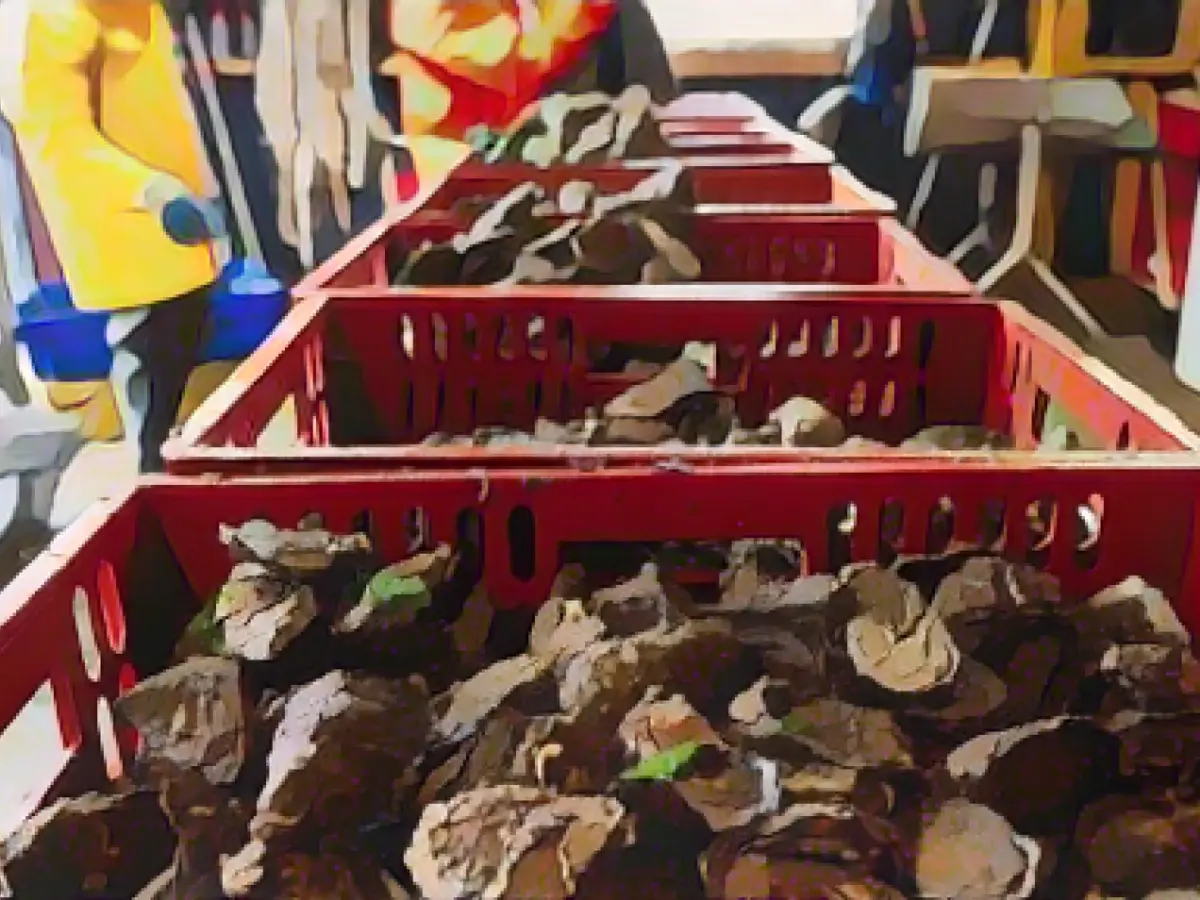Sylt Oyster Dilemma: Overabundance and Winter Storage Conundrum
Every autumn, over a million oysters from the mudflats off Sylt are whisked ashore to winter storage in seawater tanks at the local Austern-Compagnie farm, Dittmeyer. However, concerns mount as an additional 3.5 million oysters cannot find a cozy space in the tanks, leaving farmers in a pickle about the approaching winter weather.
The process is the same year after year: oysters, once home in the Wadden Sea, move into the tanks in late fall and return to their natural habitat in March. The primary objective? Protecting them from the pitiless grip of ice drift and freezing.
Dittmeyer's Austern-Compagnie operations manager, Christoffer Bohlig, shares a fascinating insight into the oyster farming world. Historically, seedlings weighed around 30-50 grams were purchased from Ireland. But now, Sylt locals are only allowed to buy mini oysters from a closed hatchery. These are just a speck of a pinhead, weighing a minuscule 0.02 grams.
By prohibiting the purchase of large oyster seedlings, Sylt is protecting its marine life from invasive species. The Pacific oyster, a common species in the Sylt Wadden Sea, now dominates the region. Overfishing and other factors led to the disappearance of the European oyster from the northern Wadden Sea in the mid-20th century.
Regrettably, this new regulation poses a significant challenge for Dittmeyer's Austern-Compagnie. The newly protected mini oysters need approximately five years to grow large enough for consumption. Meanwhile, the storage capacities were only designed for a million oysters. As a result, around 3.5 million oysters wither away, awaiting the thaw or potential freezing disaster.
Unfortunately, Mother Nature doesn't always play by the rules. Bohlig remains hopeful that the upcoming winter will be mild, but a sudden chill can bring the season to a grinding halt. If the temperatures plunge in a matter of days, the oysters will face a bleak fate cut off from their rooted homes.
After all, mini oysters are saltwater champions. They can endure chilly weather. But ice can be a menace. The net bags, or "poches," home to these mini mollusks, are virtually impervious to ice – until they aren't.
A strong, rebounding ice formation can be devastating. In essence, it's like a relentless bulldozer, grinding away at anything it comes across. As such, the oysters must be moved indoors for protection.
However, Dittmeyer's Austern-Compagnie is not alone in this predicament. The global-scale impact of invasive species and oyster farming regulations necessitates innovative solutions to the challenges posed by winter storage. Potential avenues for addressing this dilemma include:
- Offshore storage
- Climate-controlled facilities
- Regulatory compliance
- Technological innovations
- Collaboration and shared resources
- Seasonal migration.
Indeed, the essential question at hand is ensuring the survival of oyster populations while accommodating the needs of the environment and regulatory bodies. By embracing these potential solutions, oyster farmers can secure a sustainable and resilient future for their farms and the beloved Sylt Royal.
Enrichment Data:
Addressing the challenges posed by insufficient winter storage space and the related impact of invasive species requires proactive action. The following strategies can help oyster farmers mitigate risks and ensure long-term success:
- Alternative storage solutions:
- Offshore storage facilities (floating or submerged cages) that can withstand harsh weather conditions and accommodate a larger number of oysters.
- Climate-controlled storage:
- Construct or use climate-controlled warehouses: these provide a stable temperature and humidity level, ensuring optimal growth conditions and protection against extreme weather conditions.
- Regulatory compliance:
- Consult with regulatory bodies to understand the requirements and implement innovative storage methods that meet the new regulations while safeguarding oyster health.
- Technological innovations:
- Probe into advanced aquaculture systems (RAS or other technologies) that simulate natural conditions and minimize reliance on traditional storage methods.
- Collaboration and shared resources:
- Team up with other oyster farmers or aquaculture businesses to share resources and storage facilities, thus pooling risks and ensuring equitable access to storage space.
- Seasonal migration:
- Evaluate the possibility of temporarily relocating oysters to warmer waters during winter months, such as the Gulf of Mannar or other regions with favorable conditions.
By implementing these strategies, oyster farmers can confront the challenges of insufficient storage space and invasive species threats and ensure a viable future for their farms.






